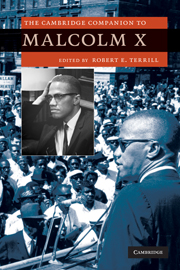Book contents
- Frontmatter
- Introduction
- 1 Malcolm X and Elijah Muhammad
- 2 Autobiography and identity: Malcolm X as author and hero
- 3 Bringing Malcolm X to Hollywood
- 4 Malcolm X and black masculinity in process
- 5 Womanizing Malcolm X
- 6 Malcolm X and the Black Arts Movement
- 7 Malcolm X and African American conservatism
- 8 Malcolm X and youth culture
- 9 Homo rhetoricus Afro-Americanus: Malcolm X and the “rhetorical ideal of life”
- 10 Judgment and critique in the rhetoric of Malcolm X
- 11 Nightmarish landscapes: geography and the dystopian writings of Malcolm X
- 12 Afrocentricity and Malcolm X
- 13 Malcolm X in global perspective
- 14 The legacy of Malcolm X
- Guide to further reading
- Index
2 - Autobiography and identity: Malcolm X as author and hero
Published online by Cambridge University Press: 28 May 2010
- Frontmatter
- Introduction
- 1 Malcolm X and Elijah Muhammad
- 2 Autobiography and identity: Malcolm X as author and hero
- 3 Bringing Malcolm X to Hollywood
- 4 Malcolm X and black masculinity in process
- 5 Womanizing Malcolm X
- 6 Malcolm X and the Black Arts Movement
- 7 Malcolm X and African American conservatism
- 8 Malcolm X and youth culture
- 9 Homo rhetoricus Afro-Americanus: Malcolm X and the “rhetorical ideal of life”
- 10 Judgment and critique in the rhetoric of Malcolm X
- 11 Nightmarish landscapes: geography and the dystopian writings of Malcolm X
- 12 Afrocentricity and Malcolm X
- 13 Malcolm X in global perspective
- 14 The legacy of Malcolm X
- Guide to further reading
- Index
Summary
Malcolm X's autobiography, written in conjunction with Alex Haley, is a gripping narrative of identity transformation. It is the extraordinary story of a young black child, Malcolm Little, adopted into a white household, who then becomes the ghetto hustler, Detroit Red, who in turn converts to the Nation of Islam and becomes Minister Malcolm X, and who finally breaks with the Nation of Islam to become El-Hajj Malik El-Shabazz, an international human-rights activist. The overall metamorphosis has a clear positive direction: each transformation seems to transcend the former, each brings with it new lessons, and the emergent Malcolm X could be likened to a butterfly escaping a cocoon. From the point of view of studying the identity and development of Malcolm X, the Autobiography is as seductive as it is gripping. It seduces the reader into conflating the Autobiography with the actual life and identity of Malcolm X in three ways. First, autobiographies have inherent rhetorical power because they are first-person accounts. For example, autobiographies have historically been used as a mode of truth telling by people who have experienced a psychotic episode, a spiritual conversion, or slavery. In the case of Malcolm's Autobiography this power is greatly heightened by the vivid writing style, which convinces the reader of the authenticity of the first-person account.
- Type
- Chapter
- Information
- The Cambridge Companion to Malcolm X , pp. 26 - 38Publisher: Cambridge University PressPrint publication year: 2010
- 7
- Cited by



